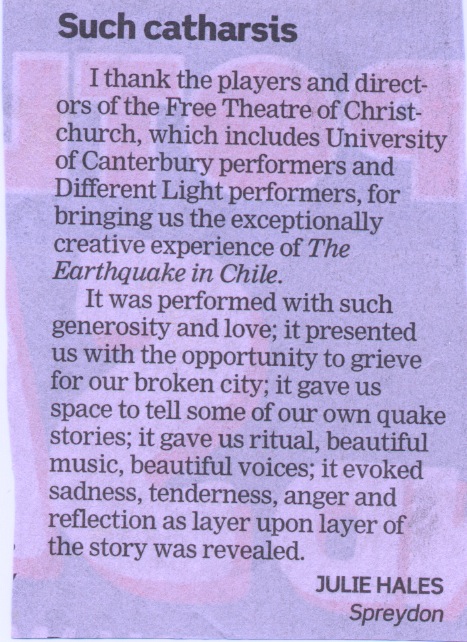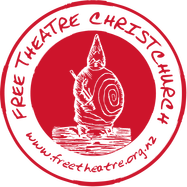A remarkable enterprise: complex and generous... It is theatre embracing the old and the new, namely us and our times. As such it deserves attention as much as applause
Lin Clark, Theatreview
One of the more remarkable theatrical 'experiences' that I have had
Jock Philips, REAL NZ Festival Insider
|
Free Theatre Christchurch's latest production The Earthquake in Chile is something of a milestone for the company. Like many of the arts organizations around the city, Free Theatre has lost its bases in the inner city (the University Theatre in the Arts Centre and Old Queen's Theatre in Hereford St) and has had to cancel two planned productions following the earthquakes. So getting this production up and running is important for Artistic Director Peter Falkenberg and ensemble.
Free Theatre is in the process of finding new places to work, but perhaps have an advantage in the current environment given the company has regularly staged productions in unusual places and spaces: nightclubs, Cathedral Square, shopping malls, the Port Hills, city streets and so on. Just as the theme of a performance might suggest a place to work in, working in the space becomes inspiration and the material of the production for the experimental theatre company. The same is true for The Earthquake in Chile, which will take place in and around the beautiful St Mary's Church in Addington. Surrounded by a small, green square, St Mary's is proving a wonderful muse for a performance that aims to explore the extraordinary sense of communion and community that emerged in the wake of the earthquakes. Not only will audiences enter into the church for the performance, they can expect to explore the surrounding square, where a series of offerings, culinary and performative, will nourish and entertain. Conceived by Falkenberg in the days following the February 22 earthquake, the idea for the performance was inspired by Falkenberg's experience in his local community in Sumner, where neighbours helped each other, and the community rallied in an unprecedented way, an occurrence, we know, that happened all over the city. Falkenberg was reminded of the Heinrich von Kleist short story 'The Earthquake in Chile' (1807), using the earthquake that struck Santiago Chile in 1647 as a catalyst for drama. In the story, it is the social structures that collapse with the buildings that leads to a new sense of community, as the shaken populace gather to feed themselves and each other in the rubble of the fallen city. The production is a collaboration with Canterbury Fellow Professor Richard Gough, the director of the Centre for Performance Research (CPR) in Aberystwyth Wales and the founding President of the influential Performance Studies International. Gough is in New Zealand to celebrate the 10-year anniversary of Te Puna Toi, the research wing of the Theatre and Film Studies Programme (TAFS) at the University of Canterbury. The TAFS programme grew out of the Free Theatre - operating now for over 30 years in Christchurch - and has maintained a unique combination of theory and practice leading to what is the most impressive postgraduate research culture in the country. Founded in 2001 as a New Zealand-based platform for performance research, Te Puna Toi has enjoyed a partnership with CPR over these past ten years, sharing with the Aberystwyth-based project, a view that the margins are a fertile ground to create new and innovative performance work. Many of the projects commissioned by Te Puna Toi have included performances by Free Theatre, such as the award-winning productions Ella and Susn and Faust Chroma. So this production is not only a milestone for the Free Theatre but a celebration of what is an extraordinary history and a rich contemporary practice. Respected New Zealand filmmaker Shirley Horrocks will also be on hand to film the performance as part of a documentary she is making on Peter Falkenberg and the Free Theatre. It is fitting that Gough should be in New Zealand for the celebrations and to add his own special ingredients to the performance. Gough himself is well known as a director and performer, his performances relating to food and the communal rituals around eating being performed in Europe, North America and Asia. Gough is teaming up with New Zealand Celebrity Chef Richard Till, Free Theatre performers and actors from A Different Light Theatre Company to provide interactive experiences and music. As a collaborative effort, it perhaps best sums up the events that inspired the performance. The question asked by director and company is, how, in laying the foundations for a new city and identity, do we keep the positive sense of community that emerged following the earthquakes, before, as in Kleist's story, the old restrictive structures return with a vengeance? |
A remarkable enterprise: complex and generous
Lindsay Clark for Theatreview The Earthquake in Chile - in Christchurch Jock Phillips for REAL NZ Festival Insider Ambitious play feast for thought Alan Scott for The Press As a community group we benefited from the creative energy from Gap Filler and Free Theatre (and like many other groups our energy levels were low). We needed a stimulus to re-establish our sense of community and resilience during difficult times and these groups provided this St Mary’s Anglican Church
"Free Fall"
Philip Matthews, The Press, 7 October 2011 "Richard Gough experimental theatre" Saturday Mornings with Kim Hill, RadioNZ, 12 November 2011 |



